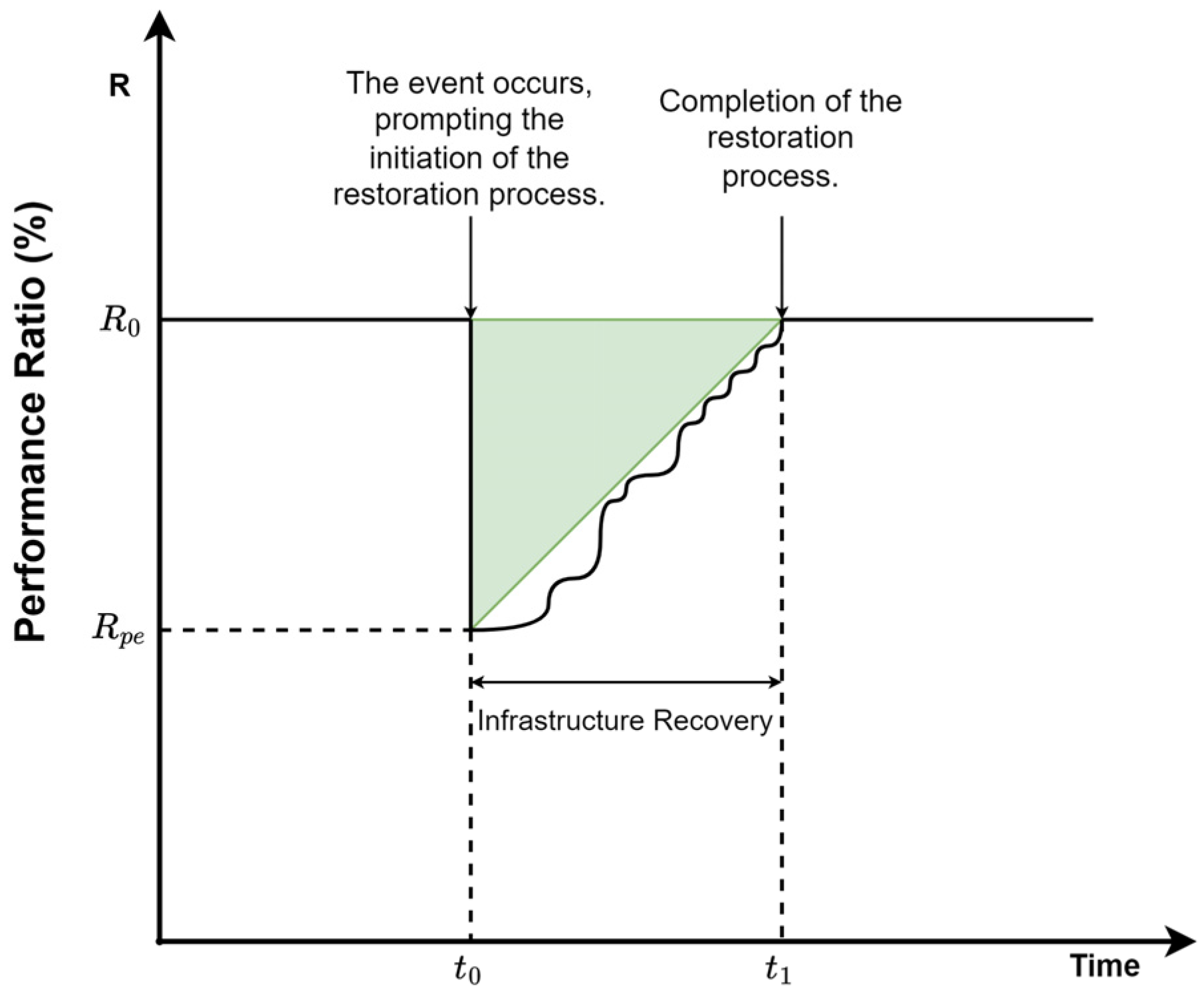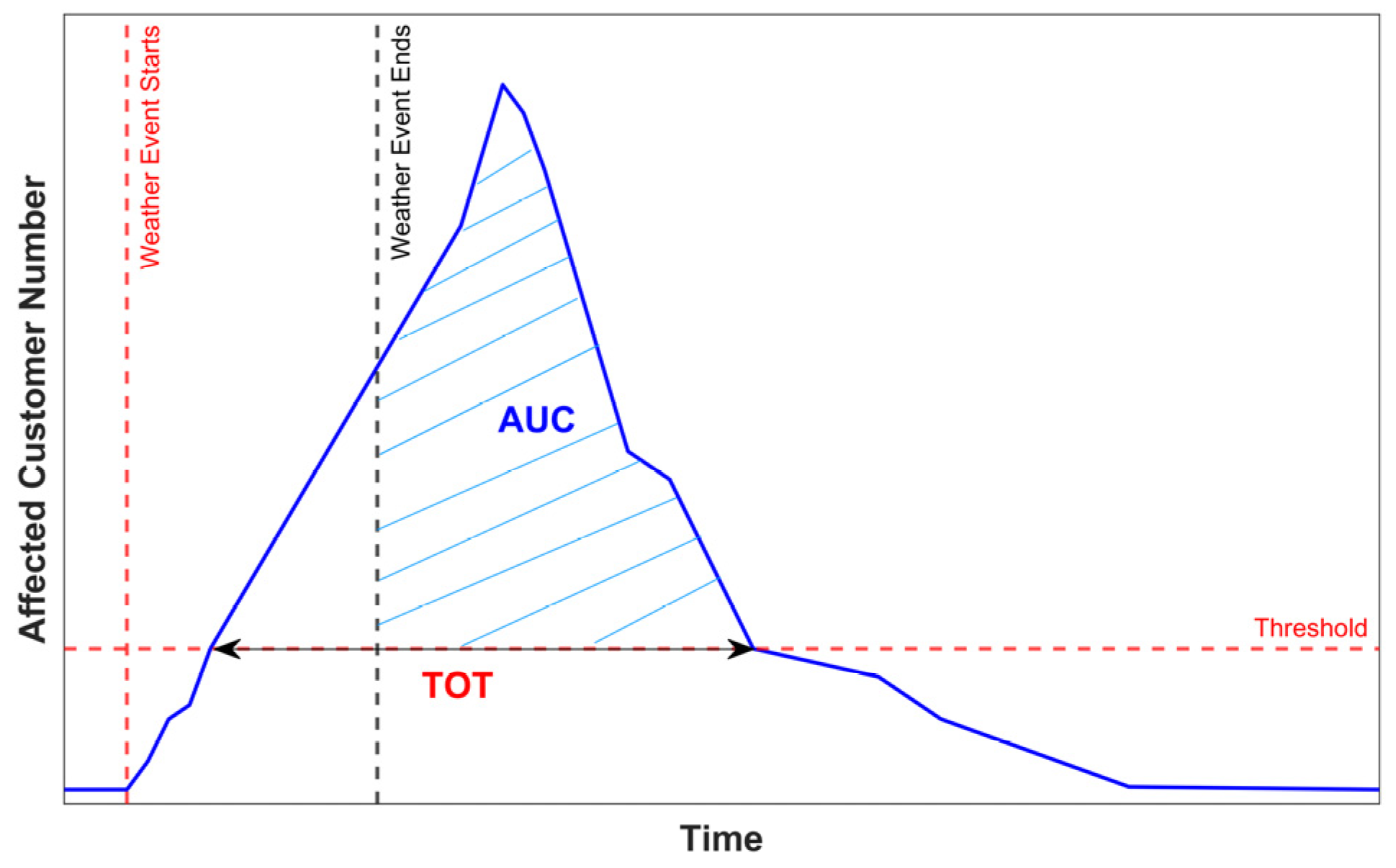Evaluation and Enhancement of Power System Resilience Under Weather Events †
Abstract
1. Introduction
- Understanding the spatiotemporal correlation between extreme events and power systems is crucial for system planning and operation. In other words, it is essential to leverage historical meteorological events and electrical outages and quantify system resilience. The resolution and reliability of collected historical data have become critically important.
- The inherent randomness and unpredictability of weather events significantly influence the assessment of power system resilience. Therefore, it is imperative to develop sophisticated modeling techniques and assess the effects of extreme weather events on power system resilience. Furthermore, accurately quantifying the impact of weather events necessitates a stochastic approach to effectively capture its variability and its effects on various system components.
2. Resilience Curves
3. Resilience Model
4. Resilience Assessment
5. Resilience Enhancement
6. Case Studies
7. Conclusions
Author Contributions
Funding
Institutional Review Board Statement
Informed Consent Statement
Data Availability Statement
Conflicts of Interest
References
- Bessani, M.; Massignan, J.A.; Fanucchi, R.Z.; Camillo, M.H.; London, J.B.; Delbem, A.C.; Maciel, C.D. Probabilistic Assessment of Power Distribution Systems Resilience Under Extreme Weather. IEEE Syst. J. 2019, 13, 1747–1756. [Google Scholar] [CrossRef]
- Panteli, M.; Mancarella, P. Modeling and Evaluating the Resilience of Critical Electrical Power Infrastructure to Extreme Weather Events. IEEE Syst. J. 2017, 11, 1733–1742. [Google Scholar] [CrossRef]
- Mujjuni, F.; Betts, T.R.; Blanchard, R.E. Evaluation of Power Systems Resilience to Extreme Weather Events: A Review of Methods and Assumptions. IEEE Access 2023, 11, 87279–87296. [Google Scholar] [CrossRef]
- Afzal, S.; Mokhlis, H.; Illias, H.A.; Mansor, N.N.; Shareef, H. State-of-the-art Review on Power System Resilience and Assessment Techniques. IET Gener. Transm. Distrib. 2020, 14, 6107–6121. [Google Scholar] [CrossRef]
- Bhusal, N.; Abdelmalak, M.; Kamruzzaman, M.; Benidris, M. Power System Resilience: Current Practices, Challenges, and Future Directions. IEEE Access 2020, 8, 18064–18086. [Google Scholar] [CrossRef]
- Nazemi, M.; Dehghanian, P.; Darestani, Y.; Su, J. Parameterized Wildfire Fragility Functions for Overhead Power Line Conductors. IEEE Trans. Power Syst. 2024, 39, 2517–2527. [Google Scholar] [CrossRef]
- Hou, G.; Muraleetharan, K.K.; Panchalogaranjan, V.; Moses, P.; Javid, A.; Al-Dakheeli, H.; Bulut, R.; Campos, R.; Harvey, P.S.; Miller, G.; et al. Resilience Assessment and Enhancement Evaluation of Power Distribution Systems Subjected to Ice Storms. Reliab. Eng. Syst. Saf. 2023, 230, 108964. [Google Scholar] [CrossRef]
- Li, B.; Mostafavi, A. Unraveling Fundamental Properties of Power System Resilience Curves Using Unsupervised Machine Learning. Energy AI 2024, 16, 100351. [Google Scholar] [CrossRef]
- Guo, C.; Ye, C.; Ding, Y.; Wang, P. A Multi-State Model for Transmission System Resilience Enhancement Against Short-Circuit Faults Caused by Extreme Weather Events. IEEE Trans. Power Deliv. 2021, 36, 2374–2385. [Google Scholar] [CrossRef]
- Lee, S.M.; Chinthavali, S.; Bhusal, N.; Stenvig, N.; Tabassum, A.; Kuruganti, T. Quantifying the Power System Resilience of the US Power Grid Through Weather and Power Outage Data Mapping. IEEE Access 2024, 12, 5237–5255. [Google Scholar] [CrossRef]
- Shi, Q.; Liu, W.; Zeng, B.; Hui, H.; Li, F. Enhancing Distribution System Resilience Against Extreme Weather Events: Concept Review, Algorithm Summary, and Future Vision. Int. J. Electr. Power Energy Syst. 2022, 138, 107860. [Google Scholar] [CrossRef]
- Wu, Y.-K.; Chen, Y.-C.; Chang, H.-L.; Hong, J.-S. The Effect of Decision Analysis on Power System Resilience and Economic Value During a Severe Weather Event. IEEE Trans. Ind. Appl. 2022, 58, 1685–1695. [Google Scholar] [CrossRef]
- Wang, C.; Ju, P.; Wu, F.; Pan, X.; Wang, Z. A Systematic Review on Power System Resilience from the Perspective of Generation, Network, and Load. Renew. Sustain. Energy Rev. 2022, 167, 112567. [Google Scholar] [CrossRef]
- Panteli, M.; Mancarella, P. Influence of Extreme Weather and Climate Change on the Resilience of Power Systems: Impacts and Possible Mitigation Strategies. Electr. Power Syst. Res. 2015, 127, 259–270. [Google Scholar] [CrossRef]
- Panteli, M.; Pickering, C.; Wilkinson, S.; Dawson, R.; Mancarella, P. Power System Resilience to Extreme Weather: Fragility Modeling, Probabilistic Impact Assessment, and Adaptation Measures. IEEE Trans. Power Syst. 2017, 32, 3747–3757. [Google Scholar] [CrossRef]
- Panteli, M.; Trakas, D.N.; Mancarella, P.; Hatziargyriou, N.D. Power Systems Resilience Assessment: Hardening and Smart Operational Enhancement Strategies. Proc. IEEE 2017, 105, 1202–1213. [Google Scholar] [CrossRef]
- Pan, W.; Li, Y. Improving Power Grid Resilience Under Extreme Weather Conditions with Proper Regulation and Management of DERs—Experiences Learned from the 2021 Texas Power Crisis. Front. Energy Res. 2022, 10, 921335. [Google Scholar] [CrossRef]




| No. | Data Sources for Climate Models | Purposes | Data Description |
|---|---|---|---|
| 1 | European Centre for Medium-Range Weather Forecasts atmospheric reanalysis (ERA5) | It provides hourly estimates of atmospheric, land, and oceanic climate variables. | The data encompass the Earth’s surface on a 30 km grid and resolve atmospheric conditions using 137 vertical levels, extending from the surface to an altitude of 80 km. |
| 2 | Global Meteorological Forcing Dataset for land surface modeling | It provides essential meteorological inputs for simulating land surface processes. | The data cover global land surfaces with high temporal resolution, typically providing hourly to daily observations for key meteorological variables, including precipitation, temperature, radiation, wind speed, humidity, and surface pressure. |
| 3 | Modern-Era Retrospective analysis for Research and Applications (MERRA) | It provides Earth’s atmospheric conditions. | The data cover the Earth on a grid of 0.5° × 0.667° and resolve the atmosphere using 72 vertical levels, extending from the surface up to 0.01 hPa (approximately 75 km). MERRA provides hourly data for a range of atmospheric, oceanic, and land surface variables, including temperature, humidity, wind, precipitation, and radiation. |
| 4 | Generalized extreme value (GEV) theory (intensities of wind and rainfall) | It estimates the probability of rare and severe wind speeds and rainfall intensities, aiding in risk assessment, infrastructure design, and enhancing preparedness for extreme weather events. | The datasets typically include the highest observed values over the specified time periods (e.g., annual maxima) and span various locations, facilitating the modeling and prediction of rare and severe events. |
| 5 | HAZUS-MH2 and UKC09 (hurricane, drought, and flood) | It assesses and models the potential impacts of natural hazards, including hurricanes, droughts, and floods. | HAZUS-MH2 and UKC09 utilize hazard-specific data, including geographic, climatic, and socio-economic information, to evaluate the potential impacts and vulnerabilities associated with hurricanes, droughts, and floods. |
| 6 | General Climate Models (GCMs) (drought, heatwave) | It can simulate and predict the long-term impacts of climate change on drought patterns and frequency. | The data encompass a global scale with varying spatial resolutions, typically ranging from 100 to 300 km, and include long-term climate variables such as temperature, precipitation, soil moisture, and evapotranspiration. |
| 7 | HAZUS-MH model by federal emergency management agency (FEMA) (flood) | It can estimate potential losses and assess the impacts of floods on communities. | The data include detailed geographic information, such as flood hazard maps, building inventories, infrastructure details, and population demographics. This information is integrated with hydrological and hydraulic models. |
| 8 | Weather Research and Forecasting (WRF) Model | It provides high-resolution weather and climate simulation data for both regional and global scales. | WRF offers a flexible, state-of-the-art atmospheric simulation system, providing various variables such as temperature, wind speed, precipitation, and more. It is suitable for use across scales, ranging from meters to thousands of kilometers. |
| 9 | Coordinated Regional Downscaling Experiment (CORDEX) | It provides regional climate downscaling data for climate impact assessments. | CORDEX provides downscaled regional climate simulations at different resolutions (0.44°, 0.22°, 0.11°) using input from global climate models. It covers various regions and includes simulations of future climate scenarios based on different Representative Concentration Pathways (RCPs). |
| Weather Events | The Method Described for Component Failure | Affected Electrical Components |
|---|---|---|
| Earthquake | A failure curve that is based on the peak ground acceleration (PGA) | Power plants, power lines |
| Lightning | Probabilistic lightning models that consider peak current, ground flash density, and other variables | Power lines, wind turbine towers |
| Heat waves | The impact on available capacity or degrading rate | Traditional power plants or PV systems |
| High winds | The failure probability of a wind turbine tower based on the stress concentration factor and wind speeds | Wind turbine towers, arcing poles |
| Flood | The damage function based on flood magnitude and maximum water depth | Power plants, power lines, substation |
| Wildfire | The reduction in line capacity owing to high temperature | Power lines |
| Ice | The failure probability of a power line based on ice thickness, precipitation rate, and freezing hours | Power lines |
| Temperature | The temperature response function | Load demand |
| Drought | The effects on cooling water and hydroelectric power | Power plants |
| Category | Various Strategies |
|---|---|
| Operation |
|
| Planning |
|
Disclaimer/Publisher’s Note: The statements, opinions and data contained in all publications are solely those of the individual author(s) and contributor(s) and not of MDPI and/or the editor(s). MDPI and/or the editor(s) disclaim responsibility for any injury to people or property resulting from any ideas, methods, instructions or products referred to in the content. |
© 2025 by the authors. Licensee MDPI, Basel, Switzerland. This article is an open access article distributed under the terms and conditions of the Creative Commons Attribution (CC BY) license (https://creativecommons.org/licenses/by/4.0/).
Share and Cite
Wu, Y.-K.; Trinh, D.-T.; Li, C.-H. Evaluation and Enhancement of Power System Resilience Under Weather Events. Eng. Proc. 2025, 92, 34. https://doi.org/10.3390/engproc2025092034
Wu Y-K, Trinh D-T, Li C-H. Evaluation and Enhancement of Power System Resilience Under Weather Events. Engineering Proceedings. 2025; 92(1):34. https://doi.org/10.3390/engproc2025092034
Chicago/Turabian StyleWu, Yuan-Kang, Duc-Tung Trinh, and Chun-Hung Li. 2025. "Evaluation and Enhancement of Power System Resilience Under Weather Events" Engineering Proceedings 92, no. 1: 34. https://doi.org/10.3390/engproc2025092034
APA StyleWu, Y.-K., Trinh, D.-T., & Li, C.-H. (2025). Evaluation and Enhancement of Power System Resilience Under Weather Events. Engineering Proceedings, 92(1), 34. https://doi.org/10.3390/engproc2025092034







